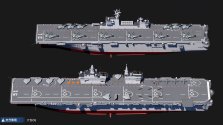MV-22 at full span is almost 26m though.On top of that, much of that extra "size" you see on Sichuan are actually due to the much wider flight deck that accounts for U(C)AVs with large wingspans (for instance, GJ-21's wingspan is ~14 meters, whereas WZ-10's wingspan can reach 20 meters). This feature is absent on the America LHAs because they only operate F-35Bs with a wingspan of 11 meters at most.
You are using an out of date browser. It may not display this or other websites correctly.
You should upgrade or use an alternative browser.
You should upgrade or use an alternative browser.
Type 076 LHD/LHA discussion
- Thread starter banjex
- Start date
In this new era, military industrial production capacity, informatization, and low detectability have become difficult goals for small countries to simultaneously achieve.Small countries tend to be more able to defend themselves individually. It's ironically big power's underdefended belly which is truly most vulnerable. Nations can't be strong everywhere.
Ukraine does not rely on aid from the US and Europe and has no ability to protect itself "alone."
Ukraine is about the size of France, with a highly skilled population of over 30 million and basic industrial capabilities.
As for large countries, while they may have undeveloped hinterlands, this also implies greater strategic depth and stronger military potential.
Returning to the Type 076, even 8-10 GJ-21 UAVs could inflict sustained damage on small countries.
A few key power plants? One or two core steel mills? A large industrial zone? The capital's largest water source?
The list wouldn't be very long.
Smaller countries are less able to withstand this. Even a country like Israel couldn't. Losing all its power plants within a week would reduce the country's industrial capacity to an unbearable level within six months.
MV-22 at full span is almost 26m though.
Well, you're right. I did miss out on that one.
However, there's this factor - The MV-22 certainly did not conduct CATOBAR operations on the America LHAs. In fact, there are no CATOBAR operations to be conducted on America - Only the F-35Bs conduct STOVL operations onboard. And as previously mentioned, the F-3B only has a wingspan of no more than 11 meters.
On the other hand, the Sichuan certainly will be conducting CATOBAR operations all the time.


(CG models used for better clarity, although the details match well with real-life object.)
Notice the location of the arresting gear wires - They are lined up along and close to the centerline of Sichuan's flight deck. This is due to the enormous amount of instantaneous force of aircrafts slamming down onto the flight deck during BAR operations (which are essentially controlled crash-landings). The structures underneath the flight deck which are supporting the portion of the flight deck where the touchdown zone is situated must be strong enough to sustain repeated slamming forces of aircrafts conducting BAR operations on the flight deck, meaning that having the zone being supported across from both sides would be the optimal solution.
On the other hand, vertical landing operations in SVTOL do not involve repeatedly slamming aircrafts hard onto the flight deck.
This should be the main reason (or one of the main reasons) for Sichuan's exceptionally wide flight deck compared every other LHDs and LHAs in existence today.
Last edited:
I agree as to the important strike role of GJ-21, but I think high op tempo operations conducted at such short ranges (076 only several dozen kms off shore) would be a poor use of GJ-21's characteristics imo.
I get the feeling that not only is 076 not a Taiwan oriented ship, I think that 076 having GJ-21 is not really useful in a "short range" (i.e.: under 100km distance) strike mission against a ground based target set, given GJ-21 has such a long range for its size and is so stealthy (if your target needs VLO to hit it then chances are you aren't going to park an amphibious strike group near the enemy).
If we think about the strike/fire support missions that GJ-21 can do off 076 which other organic naval or LHD assets cannot (including helicopters with ATGMs etc), it's basically relatively long range, high-likelihood-of-success, penetrating strike missions.
Look at the potential target set
For targets within the 1st Island Chain, these are all within range of the land-based version (GJ-11).
The advantage of a Type-076 potentially operating the GJ-21 at high tempo is negated by the risk of operating close to Japan or the Philippines, which is a dicey proposition. For the cost of a Type-076 and associated escorts, you could buy a lot more land-based GJ-21, which I reckon would provide far more strike capability, despite the additional flight time.
(Taiwan and Korea are so close to China that there's little to no advantage in operating from a Type-076 compared to a land base.
---
That leaves targets beyond the 1IC, which means the bases in the 2IC and also aircraft carriers.
So as I said some years ago, I expect the amount of time that a Type-076 actually spends on amphibious operations to be limited because there won't be that many missions.
But since you have the Type-076 anyway, during the rest of the time, it specialises in ISR and strike missions beyond the 1IC. For at least the next 10 years, the US Navy will still be larger than the Chinese Navy, which matters in blue water battles.
MV-22 at full span is almost 26m though.
Apparently this carrier is slated to launch J35s as well if needed, that would be kinda nuts.
Apparently? IMO clearly apparently not.
Was stated in global times, I'd say that's pretty credible.Apparently? IMO clearly apparently not.
